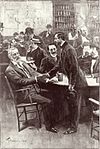Council of Fashion Designers of America
Arts organizations established in 1962Fashion awardsFashion organizationsLifetime achievement awardsUse mdy dates from December 2019

The Council of Fashion Designers of America, Inc. (CFDA), founded in 1962 by publicist Eleanor Lambert, is a not-for-profit trade association of over 450 American fashion and accessory designers. The organization promotes American designers in the global economy. In addition to hosting the annual CFDA Fashion Awards, the organization develops future American design talent through scholarships and resources in high schools, colleges, and post-graduate schools. The CFDA also provides funding and business opportunities for working designers. Through the CFDA Foundation, the organization supports charitable causes.
Excerpt from the Wikipedia article Council of Fashion Designers of America (License: CC BY-SA 3.0, Authors, Images).Council of Fashion Designers of America
Bleecker Street, New York Manhattan
Geographical coordinates (GPS) Address Nearby Places Show on map
Geographical coordinates (GPS)
| Latitude | Longitude |
|---|---|
| N 40.726267 ° | E -73.995138 ° |
Address
Le Pain Quotidien
Bleecker Street 65
10012 New York, Manhattan
New York, United States
Open on Google Maps







